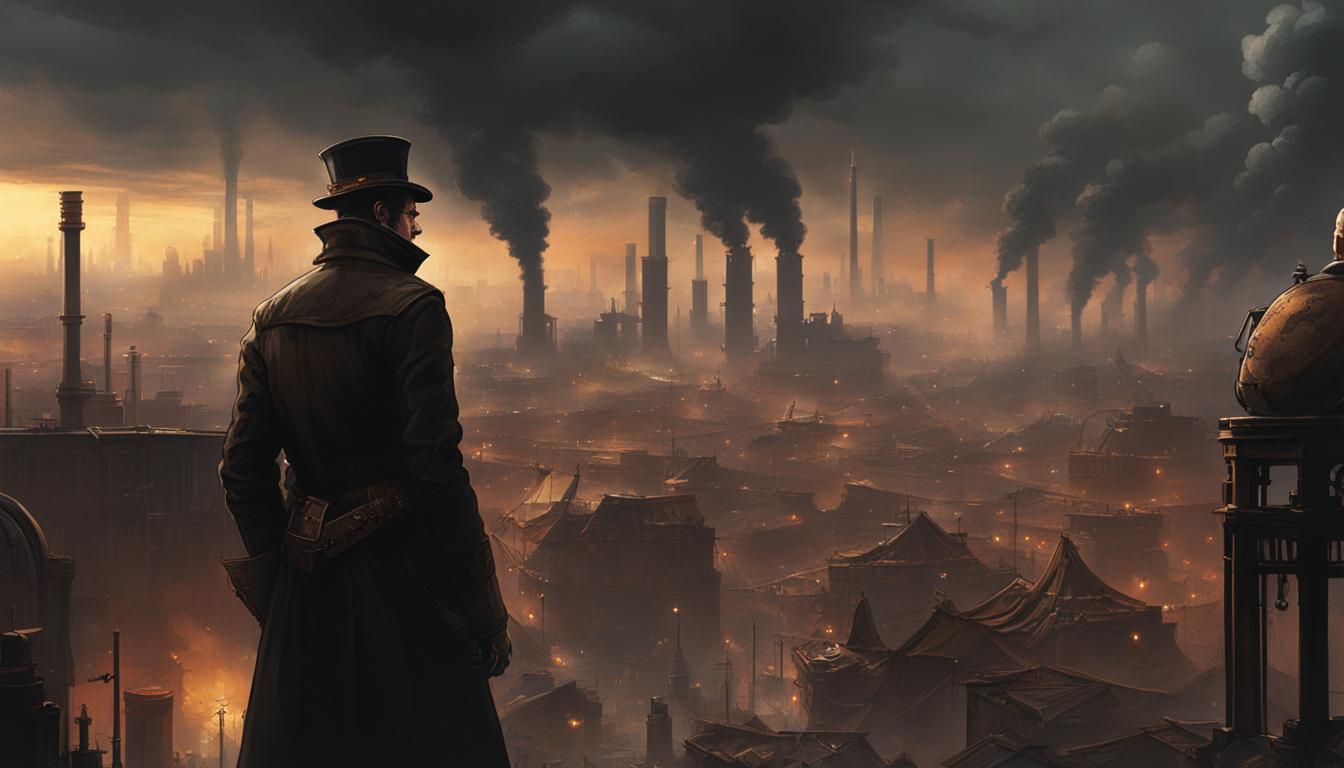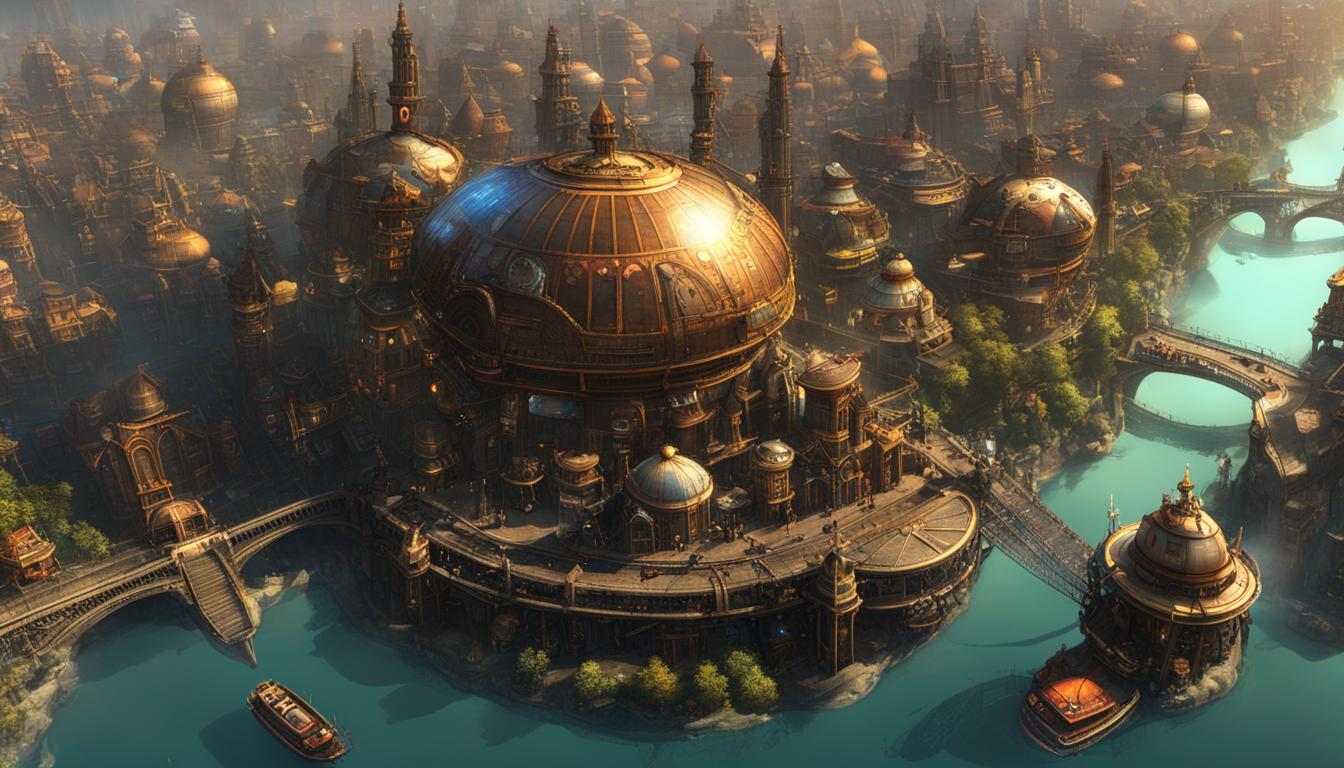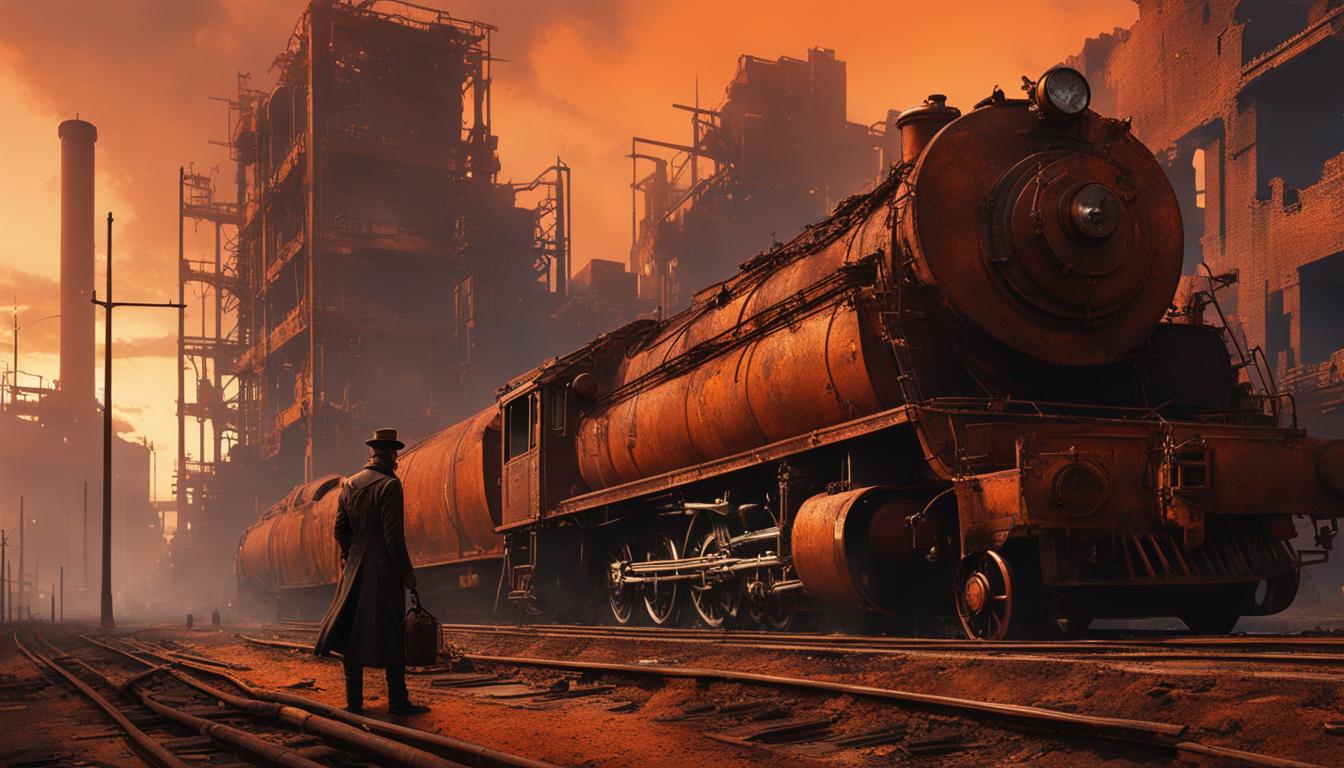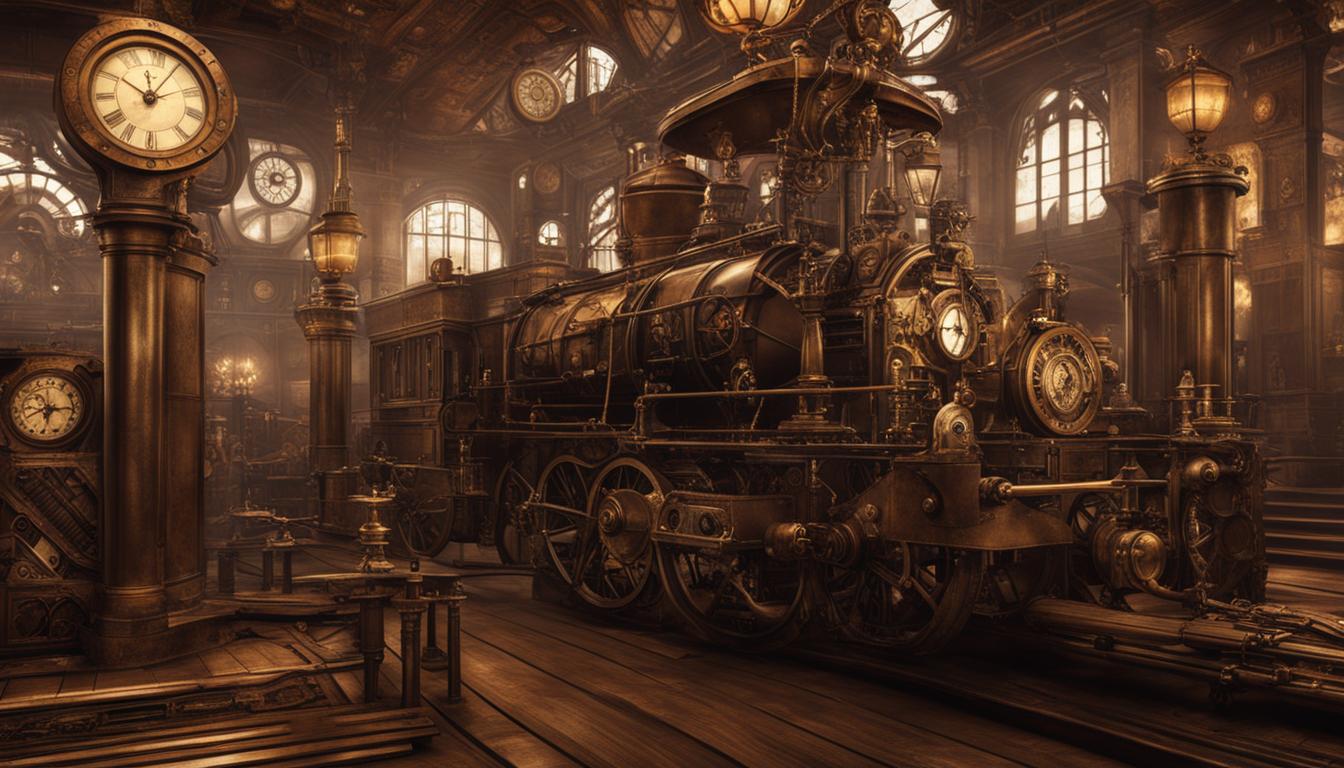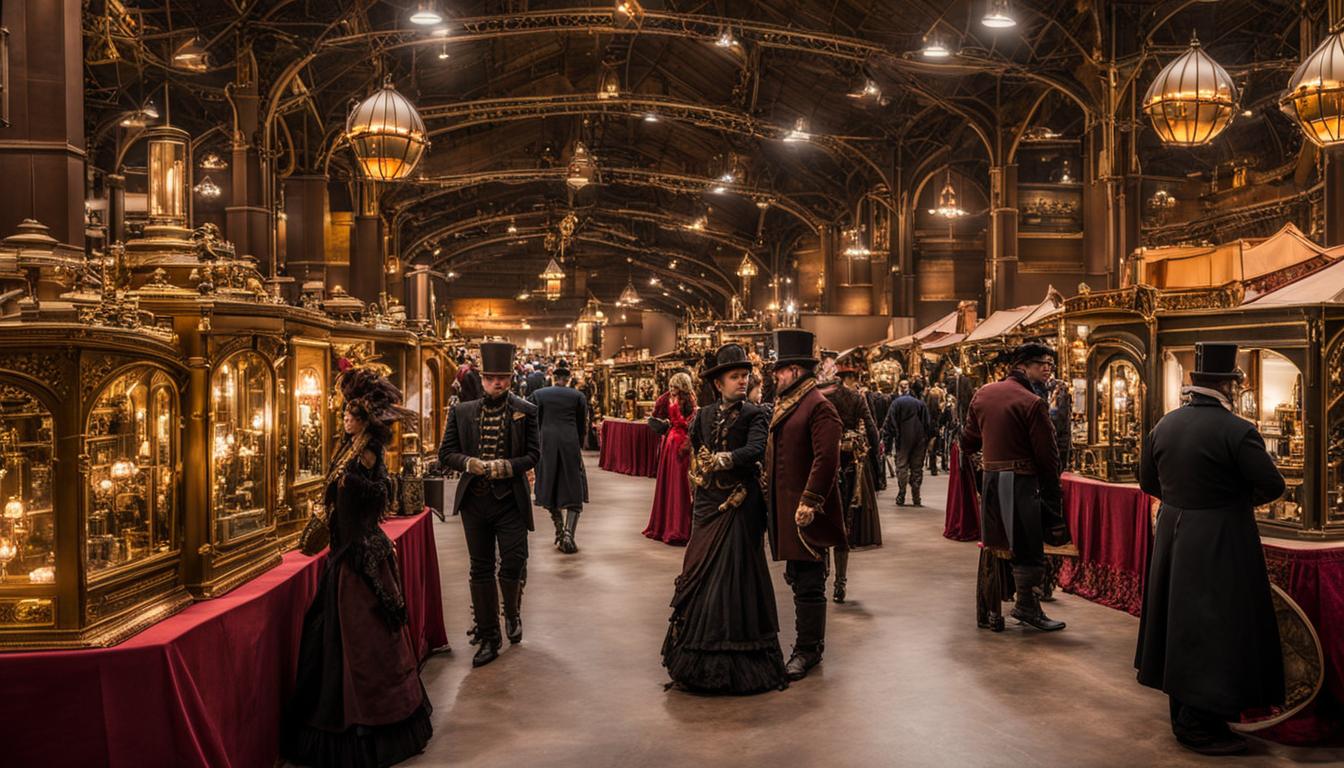Steampunk, a subgenre of science fiction, combines the aesthetics of the Victorian era with advanced technology and futuristic elements. While typically focused on an alternative 19th-century world, steampunk also incorporates dystopian elements. In dystopian steampunk media, societies are in decline, with people oppressed by technological advancements. This unique fusion of dystopia and steampunk explores themes of oppression, societal decline, and the consequences of technological advancement.
- Dystopian steampunk media blends Victorian aesthetics with retro-futuristic technology.
- In dystopian steampunk, societies are in decline, and people face oppression.
- The genre explores themes of societal decline and the consequences of technology.
- Steampunk literature and films have prominently embraced dystopian elements.
- Steampunk fashion plays a crucial role in bringing the dystopian aesthetic to life.
The Origins of Steampunk and Dystopian Fiction
Steampunk, a unique subgenre of science fiction, finds its roots in the works of Jules Verne and H.G. Wells. These visionary authors explored futuristic concepts and the impact of technology on society, often incorporating Victorian-era fashion and aesthetics. Steampunk literature emerged as a genre that combined retro-futuristic machinery with alternate histories, creating a distinct blend of the old and the new.
As steampunk evolved, it began to incorporate dystopian elements, delving into the darker sides of society and the consequences of technological advancements. This fusion of steampunk and dystopia gave birth to captivating dystopian steampunk novels and series. These narratives transport readers to worlds where society is in decline, oppressive systems control the population, and individuals must navigate their way through the complexities of a dystopian society.
Steampunk’s Take on Dystopian Worlds
“The steampunk genre allows us to explore the limitations and dangers of unchecked technological advancements by placing them within the framework of a dystopian society. It forces us to question the consequences of progress and the potential loss of humanity in the face of advancing technology.”
Steampunk’s take on dystopian worlds offers a unique perspective on societal decline and the consequences of technological advancement. By blending the captivating world-building of steampunk with the gritty realities of dystopian societies, these stories provoke thought and invite readers to consider the potential implications of progress.
Steampunk and dystopia in literature have sparked the imagination of readers worldwide. As the genre continues to evolve, new novels and series push the boundaries of dystopian steampunk, offering fresh perspectives on societal structures, power dynamics, and the human condition. With its captivating blend of historical aesthetics, futuristic elements, and thought-provoking narratives, dystopian steampunk literature remains a compelling genre that captivates and challenges readers.
With roots in the science fiction and fantasy literature of Jules Verne and H.G. Wells, steampunk has not only become a genre of its own but has also paved the way for dystopian narratives within its unique aesthetic. The fusion of steampunk and dystopia has captivated audiences across various mediums, from literature to film and fashion. The dystopian steampunk genre continues to evolve, inspiring new tales and thought-provoking discussions about the future of society.
Table: Steampunk and Dystopian Fiction
| Steampunk | Dystopia |
|---|---|
| Blends the aesthetics of the Victorian era with advanced technology | Depicts a society in decline, often oppressed or controlled by technological advancements |
| Takes inspiration from retro-futuristic machinery powered by steam | Explores themes of oppression, societal decline, and the consequences of technological advancement |
| Originates from the works of Jules Verne and H.G. Wells | Emerges as a subgenre that delves into the darker sides of society and presents alternate dystopian worlds |
Dystopian Themes in Steampunk Films
Steampunk’s unique blend of Victorian aesthetics and advanced technology has found its way into the world of film, bringing with it dystopian themes that add depth and intrigue to the genre. Steampunk films often transport viewers to a future where oppressive regimes and corrupt governments control society, creating a dystopian setting that resonates with audiences.
Visually, steampunk films are a treat for the eyes, with airships soaring through polluted skies and intricate machinery fueled by steam. The combination of Victorian fashion and futuristic technology creates a distinctive and captivating visual appeal. From the ornate clockwork mechanisms to the elaborate costumes adorned with gears and cogs, steampunk films offer a unique blend of retro-futurism and dystopia.
“Steampunk films bring the dystopian world of the genre to life, offering audiences a visually stunning and thought-provoking experience.”
One notable example of a steampunk film with dystopian elements is “Metropolis” (1927), directed by Fritz Lang. Set in a futuristic city where the wealthy elite live above ground and the working class toils beneath the surface, the film explores themes of social inequality and the dehumanization of technology. “Metropolis” showcases the dark side of technological advancement and the consequences it can have on society.
The Dystopian Elements in Steampunk Films
- Oppressive regimes and corrupt governments
- Social inequality and class divide
- Dystopian settings with polluted skies and crumbling societies
- Depictions of dehumanization and the consequences of unchecked technological advancement
Steampunk films offer a unique blend of dystopia and retro-futurism, providing audiences with visually stunning and thought-provoking experiences. Through their captivating aesthetics and exploration of societal issues, these films have become an essential part of the dystopian steampunk genre.
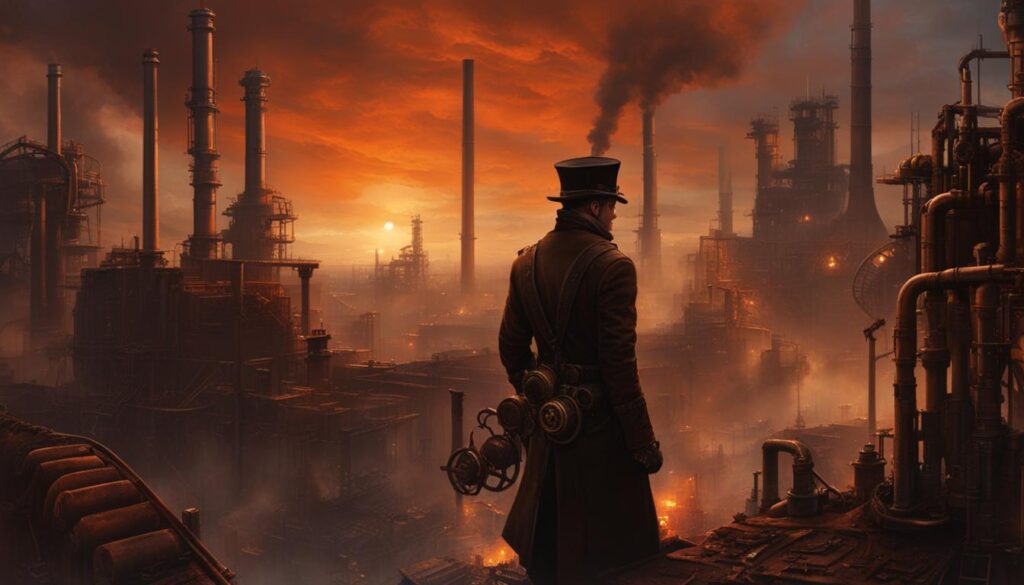
Dystopian Narratives in Steampunk Literature
The world of dystopian steampunk literature is a captivating blend of compelling narratives and imaginative world-building. In these novels, readers are transported to alternate realities characterized by societal decline, oppressive regimes, and the consequences of technological advancements. The fusion of steampunk aesthetics and dystopian themes creates a unique reading experience that explores themes of resistance, survival, and the pursuit of freedom.
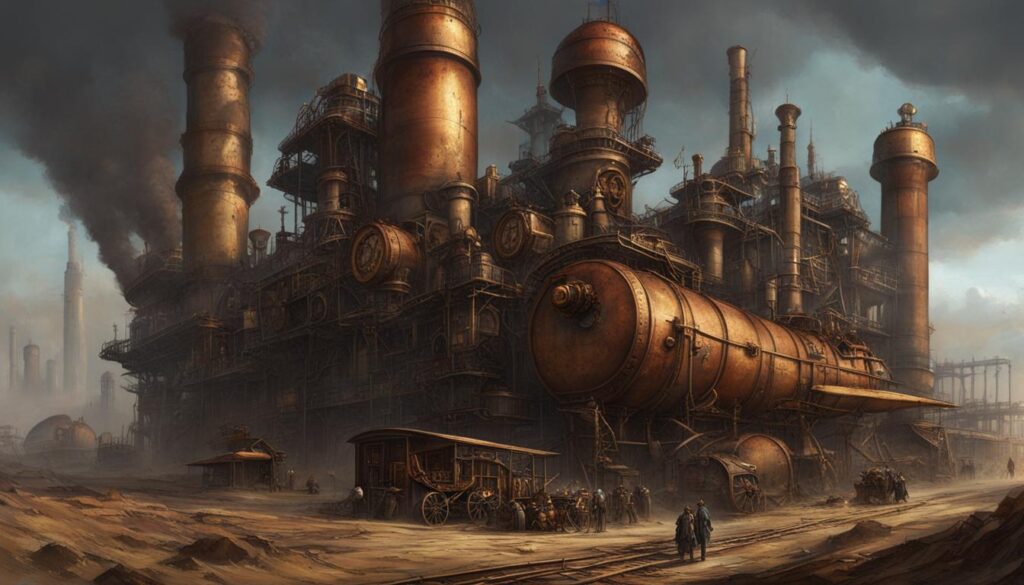
Steampunk literature often features intricate world-building, with detailed descriptions of steam-powered machinery, Victorian-inspired fashion, and gritty dystopian landscapes. The vivid imagery and attention to detail in these novels immerse readers in a rich and visually engaging reading experience.
Authors of dystopian steampunk novels not only captivate readers with their imaginative storytelling but also challenge societal norms and raise thought-provoking questions about the consequences of unchecked progress. Through the lens of dystopia, they explore the darker aspects of human nature, power dynamics, and the impact of technology on society.
The Immersive World of Dystopian Steampunk
Steampunk literature transports readers to worlds where cogs, gears, and steam-powered contraptions coexist with societal decay and oppression. The combination of these distinct elements creates a visually stunning backdrop for compelling narratives that delve into the complexities of human nature and the consequences of unchecked progress.
“In the dystopian steampunk world, machines hissed and clanked like living organisms, while towering factories spewed out black smoke, polluting the skies. Against this backdrop, characters navigate treacherous political landscapes, fight against oppressive regimes, and uncover hidden truths that threaten the fabric of society.”
These novels offer readers an escape into a world of imagination, where they can explore the possibilities of alternative histories and futures. The genre continues to evolve, introducing new voices and perspectives that challenge conventions and push the boundaries of storytelling.
| Elements of Dystopian Steampunk Novels | Key Examples |
|---|---|
| Complex world-building | “Perdido Street Station” by China Miéville |
| Exploration of societal power dynamics | “The Windup Girl” by Paolo Bacigalupi |
| Resistance against oppressive regimes | “Leviathan” by Scott Westerfeld |
| Consequences of unchecked technological advancement | “The Alchemy of Stone” by Ekaterina Sedia |
These novels not only entertain but also serve as a reflection of our own society. They encourage readers to question the impact of technology, the distribution of power, and the importance of individual agency in the face of oppressive systems.
As the genre continues to evolve, readers can look forward to new and exciting dystopian steampunk novels that challenge their perceptions, ignite their imaginations, and offer a unique perspective on the complexities of the human experience.
Steampunk’s Impact on Dystopian Pop Culture
The genre of dystopian steampunk has had a significant impact on popular culture, captivating audiences across various mediums. Steampunk’s unique blend of Victorian aesthetics, futuristic technology, and dystopian themes has sparked discussions about societal structures, power dynamics, and the consequences of unchecked technological advancement. From literature to film, television, and art, dystopian steampunk has inspired a vibrant and engaged community that continues to explore and celebrate this genre.
Steampunk’s influence can be seen in the conventions and gatherings held around the world, where enthusiasts showcase their elaborate steampunk costumes, immersing themselves in the dystopian world they admire. The visual appeal of steampunk fashion, with its use of corsets, bustles, top hats, gears, and clockwork motifs, creates a captivating visual identity for the genre. This unique fashion plays a crucial role in bringing the dystopian elements of steampunk to life, showcasing the fusion of historical aesthetics and futuristic dystopia.
“Steampunk’s blend of Victorian aesthetics, futuristic technology, and dystopian themes has captivated audiences and sparked discussions about societal structures, power dynamics, and the consequences of unchecked technological advancement.”
Steampunk has not only influenced fashion but also other forms of media. Several steampunk films have explored dystopian themes, depicting futuristic societies dominated by oppressive regimes or corrupt governments. These films bring the world of dystopian steampunk to life with their visually stunning portrayal of airships soaring through polluted skies and intricate machinery fueled by steam. The compelling blend of steampunk aesthetics and dystopian settings creates thought-provoking films that transport audiences to captivating and visually striking worlds.
| Impact of Dystopian Steampunk on Pop Culture | Examples |
|---|---|
| Inspired literature, film, television, and art | Books: “The Infernal Devices” series by Cassandra Clare Films: “City of Ember” (2008) Television: “The Man in the High Castle” (2015-2019) Art: Steampunk-inspired artwork by James Ng |
| Vibrant and engaged community | Steampunk conventions and gatherings Steampunk-themed events and parties |
| Influence on fashion | Steampunk-inspired fashion trends Elaborate steampunk costumes at conventions |
| Exploration of dystopian themes in film | Films: “The City of Lost Children” (1995) “Brazil” (1985) “Lemony Snicket’s A Series of Unfortunate Events” (2004) |
The impact of dystopian steampunk on pop culture is undeniable, with its ability to provoke thought and inspire creativity continuing to fascinate audiences worldwide. As the genre evolves, readers, viewers, and fans can look forward to new and exciting tales set in dystopian steampunk worlds, further expanding the boundaries and possibilities of this captivating genre.
Exploring Dystopia in Steampunk Fashion
Steampunk fashion plays a crucial role in bringing the dystopian elements of the genre to life. Drawing inspiration from the Victorian era, steampunk fashion combines vintage styles with futuristic elements, creating a distinct and visually striking look. The use of corsets, bustles, top hats, gears, and clockwork motifs adds an air of authenticity to the dystopian steampunk aesthetic.
Steampunk enthusiasts often participate in events and conventions where they showcase their elaborate steampunk costumes, further immersing themselves in the dystopian world they admire. The fashion of steampunk acts as a visual representation of both the Victorian era and the futuristic dystopia, creating a unique and captivating visual identity for the genre.
“Steampunk fashion is an artistic expression that allows people to step into a world of dystopian imagination,” says fashion designer and steampunk enthusiast, Amelia Sparks. “It’s a way for individuals to transport themselves to an alternative reality where the Industrial Revolution never ended and futuristic technology is powered by steam. The fashion choices in steampunk evoke a sense of adventure, rebellion, and individuality, capturing the spirit of dystopia in a visually striking way.”
Exploring Dystopian Steampunk Fashion Trends
Steampunk fashion trends are constantly evolving, with designers and enthusiasts pushing the boundaries of creativity. While the staples of corsets, goggles, and top hats remain popular, new elements and adaptations continue to emerge. From cyberpunk influences to post-apocalyptic aesthetics, steampunk fashion reflects the ever-changing landscape of dystopian worlds.
- Neo-Victorian Silhouettes: Steampunk fashion often features exaggerated silhouettes that harken back to the Victorian era. Clockwork-inspired accessories, such as gears and cogs, are incorporated into garments to add a futuristic twist.
- Industrial Accents: Utilitarian elements such as belts, buckles, and harnesses add an industrial edge to steampunk fashion. These accents not only enhance the dystopian aesthetic but also serve a functional purpose in the imagined world of steampunk.
- Mixed Textures and Materials: Steampunk fashion embraces a mix of textures and materials, combining leather, lace, metal, and fabric to create visually interesting and intricate designs. This layering of textures adds depth and richness to the costumes, further immersing the wearer in the dystopian steampunk world.
Overall, steampunk fashion offers a unique and captivating take on dystopian worlds. It allows individuals to express their creativity, immerse themselves in a visually stunning alternative reality, and evoke a sense of adventure and rebellion. With its blend of Victorian aesthetics, futuristic elements, and dystopian themes, steampunk fashion continues to push the boundaries of imagination and captivate audiences worldwide.
| Steampunk Fashion Trends | Description |
|---|---|
| Neo-Victorian Silhouettes | Exaggerated silhouettes inspired by the Victorian era, incorporating clockwork-inspired accessories. |
| Industrial Accents | Utilitarian elements like belts, buckles, and harnesses for an industrial edge. |
| Mixed Textures and Materials | Combining leather, lace, metal, and fabric to create visually rich and intricate designs. |
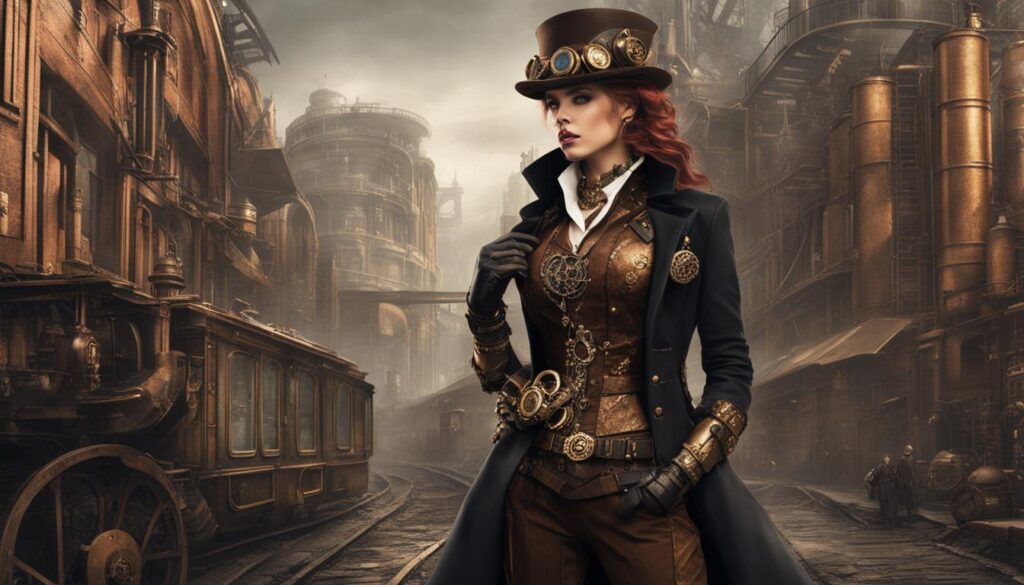
The Evolving Landscape of Dystopian Steampunk Literature
Steampunk literature has always been known for its ability to transport readers to imaginative and captivating worlds. But when combined with dystopian themes, it takes storytelling to a whole new level. Dystopian steampunk novels have gained immense popularity for their unique blend of historical aesthetics, futuristic elements, and thought-provoking narratives.
Authors continue to push the boundaries of the genre, exploring the consequences of unchecked technological advancement and societal decline. With each new release, dystopian steampunk literature offers readers the opportunity to escape into alternative worlds where steam-powered technology reigns supreme.
These novels often feature characters navigating oppressive systems, resisting authority, and fighting for freedom. The worlds they inhabit are grim and gritty, with society on the brink of collapse. As readers delve into these stories, they are confronted with profound questions about power, control, and the consequences of human actions.
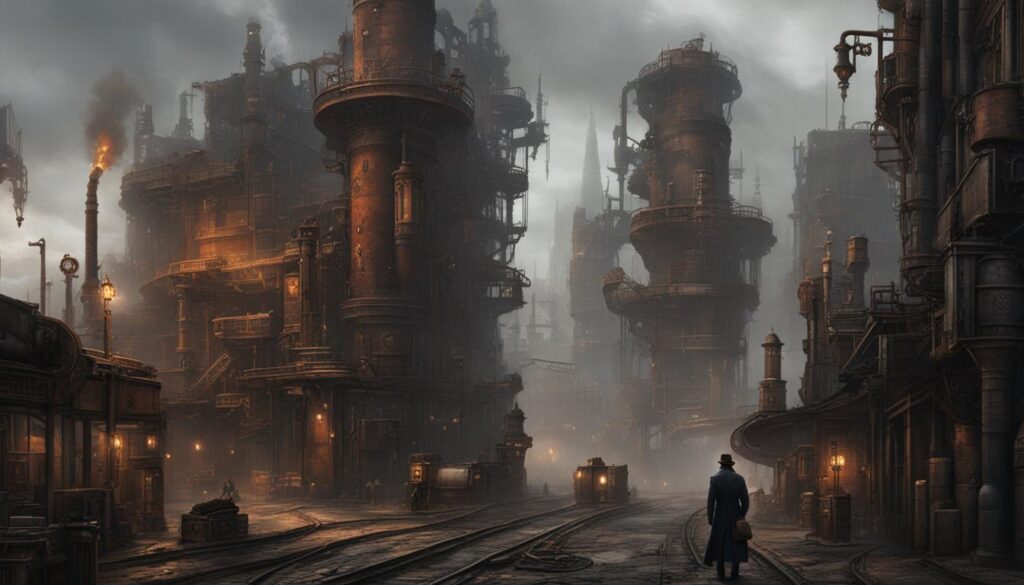
Table: Comparison of Dystopian Steampunk Novels
| Novel | Author | Release Year |
|---|---|---|
| The Iron Empire | Samuel Hawke | 2020 |
| The Clockwork Dynasty | Daniel H. Wilson | 2017 |
| Perdido Street Station | China Miéville | 2000 |
| Boneshaker | Cherie Priest | 2009 |
As seen in the table above, there is a wide variety of dystopian steampunk novels available to readers. Each novel offers a unique perspective on the genre, whether it’s exploring the consequences of technology, challenging power structures, or examining the resilience of the human spirit.
As the landscape of dystopian steampunk literature continues to evolve, readers can look forward to new and exciting tales set in these intriguing worlds. With each new release, the genre pushes the boundaries of imagination, inviting readers to explore the complexities of human nature and the consequences of our actions.
Conclusion
In the world of dystopian steampunk media, the possibilities are endless. From literature to film, fashion to art, exploring the intersection of dystopia and steampunk has captivated audiences and sparked the imagination. This unique genre combines the visually stunning steampunk aesthetic with the thought-provoking themes of dystopian narratives, resulting in a genre that challenges societal norms and dives deep into the consequences of technology.
Whether it’s delving into oppressive regimes or navigating a society on the brink of collapse, exploring dystopia in steampunk media offers an immersive experience that leaves audiences captivated. The blend of retro-futuristic machinery, Victorian fashion, and dystopian settings creates a rich tapestry for storytelling, allowing for engaging narratives that examine the complexities of human nature.
As the genre continues to evolve, readers and viewers can look forward to new tales set in dystopian steampunk worlds. The exploration of societal decline, power dynamics, and the consequences of unchecked technological advancement will undoubtedly provoke thought and inspire creativity for years to come. So step into the world of dystopian steampunk media, where imagination knows no bounds.
FAQ
What is steampunk?
Steampunk is a subgenre of science fiction that combines the aesthetics of the Victorian era with advanced technology and futuristic elements, often powered by steam.
What is dystopian steampunk?
Dystopian steampunk is a subgenre within steampunk that incorporates dystopian elements, exploring themes of societal decline, oppression, and the consequences of technological advancement.
What are some notable authors who have contributed to dystopian steampunk literature?
Jules Verne and H.G. Wells, among others, laid the foundation for the genre with their exploration of futuristic concepts and alternative histories. Contemporary authors continue to expand the genre.
How does steampunk fashion contribute to the dystopian elements of the genre?
Steampunk fashion draws inspiration from the Victorian era and combines vintage styles with futuristic elements, creating a visually striking and authentic representation of the dystopian steampunk aesthetic.
How has dystopian steampunk influenced popular culture?
Dystopian steampunk has inspired literature, film, television, and art, sparking discussions about societal structures, power dynamics, and the consequences of unchecked technological advancement.
Are there any events or gatherings dedicated to steampunk enthusiasts?
Yes, the steampunk community is vibrant and engaged, with conventions and gatherings held around the world where enthusiasts showcase their elaborate steampunk costumes and immerse themselves in the dystopian world they admire.
Is dystopian steampunk literature still evolving?
Absolutely! Dystopian steampunk continues to be a constantly evolving genre, with new novels and series released regularly, exploring fresh perspectives on societal decline, oppressive systems, and the consequences of technological advancement.
What can audiences expect from dystopian steampunk media?
Dystopian steampunk media offers a captivating and immersive experience, combining the visual appeal of the steampunk aesthetic with thought-provoking themes of dystopian narratives, challenging societal norms, and delving into the complexities of human nature.

